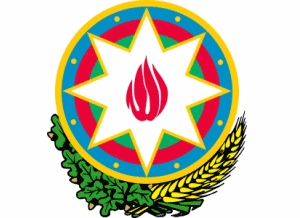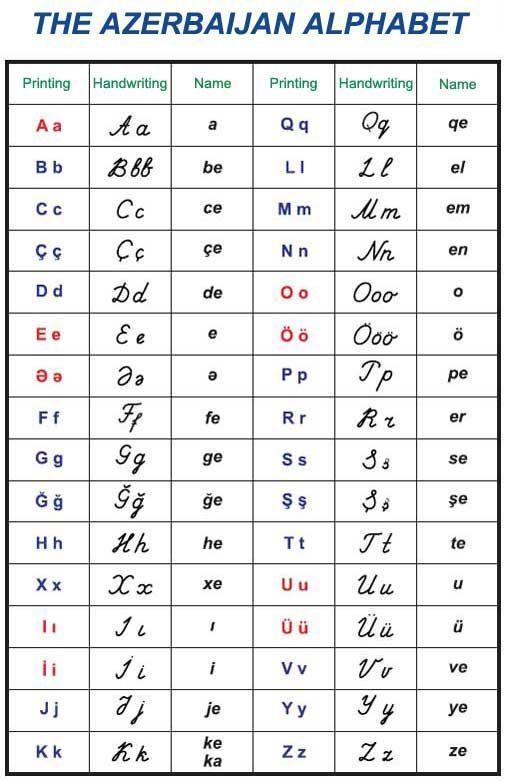General information
Azerbaijan- Land of fire
 We want to tell you about the wonderful country - Azerbaijan, about its unique nature, unique culture, long history; about the population of this country - their life, customs and traditions; about a young but already playing an important role in world politics of the state.
We want to tell you about the wonderful country - Azerbaijan, about its unique nature, unique culture, long history; about the population of this country - their life, customs and traditions; about a young but already playing an important role in world politics of the state.
The etymology of the name "Azerbaijan" has an ancient origin. We know that the majority of the population living in this territory before our era were fire worshipers. So, according to one version, the name comes from the word "Azer", which means fire, flame. According to another version, the name of the country comes from the combination of the words "az" and "er", used in ancient times on the territory of Azerbaijan. In Turkish languages, the word "az" has such meanings as good aspiration, good fortune, and "er"- (brave) man, son of a man of courage, keeper of fire.
 This fertile, generous and affectionate land was the cradle of many thinkers, philosophers, scientists, poets, architects, musicians, artists. According to legend, Zardusht (Zoroaster) was born on this earth. The Azerbaijani land gave humanity such geniuses as Nizami Ganjavi, Khagani Shirvani, Bakhmanyar, Nasimi, Fyuzuli, Nasiraddin Tusi, Shah Ismail Khatai, Molla Panah Vagif, A. Bakihanov, MF Akhundov, M.A. Sabir, J. Mammadkulisade , Hussein Javid, J. Jabbarli, Samad Vurgun, Aliaga Vahid, Rasul Rza.
This fertile, generous and affectionate land was the cradle of many thinkers, philosophers, scientists, poets, architects, musicians, artists. According to legend, Zardusht (Zoroaster) was born on this earth. The Azerbaijani land gave humanity such geniuses as Nizami Ganjavi, Khagani Shirvani, Bakhmanyar, Nasimi, Fyuzuli, Nasiraddin Tusi, Shah Ismail Khatai, Molla Panah Vagif, A. Bakihanov, MF Akhundov, M.A. Sabir, J. Mammadkulisade , Hussein Javid, J. Jabbarli, Samad Vurgun, Aliaga Vahid, Rasul Rza.
The picturesque nature of the country is reflected in the art canvases of Sattar Bahlulzade, Tahir Salahov, Togrul Narimanbekov, Mikail Abdullayev and other talented masters of art.
Our music, mugams inspired such outstanding composers as Uzeyir Hajibeyov, Muslim Magomayev, Kara Karayev, Fikret Amirov, Niyazi, Arif Melikov to give us songs sounding all over the world today, they gave us such singers with a magical, charming voice, like Byulbyul, Rashid Behbudov.

Famous Azerbaijani carpets absorbed all the colors, colors of nature, all our rich history. Today, like magic carpets, without knowing the boundaries of time and space, they reach the most distant countries
The science and education of Azerbaijan has a long history. Established in 1919, the Baku State University, the institutes of the Academy of Sciences of Azerbaijan created in 1945, played a crucial role in the development of science, education and culture in the republic and gave the world a galaxy of famous scientists in various fields.
 For decades, the country's industry represented oil production, the chemical industry, metallurgy, machinery, and agriculture- cotton, viticulture, vegetable and livestock.
For decades, the country's industry represented oil production, the chemical industry, metallurgy, machinery, and agriculture- cotton, viticulture, vegetable and livestock.
If we compare the economy of Azerbaijan with a living organism, we can say that oil flows through its “veins”. Oil and gas production has made this place famous since ancient times.Today, speaking of Azerbaijan, its main wealth appears before its eyes - oil. Oil is not only wealth, but also fame. In the distant past, the representatives of various countries came to this region for a liquid with a specific smell and color. For millennia, oil filled with skins carried the camel caravan to the East, the West. The oil exported from Azerbaijan was used not only for illumination, but also as a valuable medicine against many diseases.

Now, large-scale energy, oil and gas projects are being successfully implemented in the Azerbaijani sector of the Caspian Sea.
Azerbaijan has become a state that first mastered the powerful energy potential of the Caspian Sea and forms a qualitatively new economic model in the development of the region, which plays an important role in the Caspian and Caucasus region in expanding political and trade relations between Europe and Asia, in developing the Caucasus transport corridor, in implementing projects world value.
 At present, Azerbaijan is a member of such international organizations as the United Nations (UN), the Security and Commonwealth Organization in Europe (OSCE), the Council of Europe (CoE), the Commonwealth of Independent States (CIS), GUAM, the Organization of the Islamic Conference (OIC), The Organization of the Black Sea Economic Cooperation (BSEC), the Economic Cooperation Organization (ECO), actively cooperates with the European Union, NATO, the International Monetary Fund, the European Bank for Reconstruction and Development, the Islamic Bank of Ra Vitia and other organizations, joins the new joint documents and international treaties.
At present, Azerbaijan is a member of such international organizations as the United Nations (UN), the Security and Commonwealth Organization in Europe (OSCE), the Council of Europe (CoE), the Commonwealth of Independent States (CIS), GUAM, the Organization of the Islamic Conference (OIC), The Organization of the Black Sea Economic Cooperation (BSEC), the Economic Cooperation Organization (ECO), actively cooperates with the European Union, NATO, the International Monetary Fund, the European Bank for Reconstruction and Development, the Islamic Bank of Ra Vitia and other organizations, joins the new joint documents and international treaties.
Territory of Azerbaijan

|
Territory 86.6 thousand km2 (12% of forest, 1.7% of the water basin, 54.9% of arable land, including 31.1% of meadows and pastures, 31.4% of other lands). The country is between 44 ° and 52 ° east longitude, 38 ° and 42 ° north latitude, Baku is at 40 ° parallel. Capital Large lakes, km2 The largest lake in the world Highest mountain |
Neighbors State borders: 765 km in the south with Iran and 15 km with Turkey, 390 km in the north with Russia, 480 km in the north-east with Georgia, 1007 km in the west with Armenia. The length of the widest section of the Caspian Sea in the Azerbaijan sector is 456 km Large islands, km2 Pirallahi - 14.4 Large rivers, km |
Population of Azerbaijan
On September 1, 2014, the population of the Republic of Azerbaijan was 9 million 552 thousand 5 people. 53.2% of the population live in the city and 46.8% live in villages. 49.7% of the population are men and 50.3% women.
State Symbols of the Republic of Azerbaijan
The state symbols of the Republic of Azerbaijan are the State Flag of the Republic of Azerbaijan, the State Emblem of the Republic of Azerbaijan and the National Anthem of the Republic of Azerbaijan.
State Flag
 The national flag of the Republic of Azerbaijan consists of three equal horizontal widths. The upper band is blue, the middle band is red, the lower band is green. The blue color means the Turkic origin of the Azerbaijani people, the red color reflects the course towards the modernization of society and the development of democracy, and the green color indicates belonging to the Islamic civilization. In the middle of the red strip on both sides of the flag, a crescent with an eight-pointed star is shown in white. The ratio of the width of the flag to its length is 1:2.
The national flag of the Republic of Azerbaijan consists of three equal horizontal widths. The upper band is blue, the middle band is red, the lower band is green. The blue color means the Turkic origin of the Azerbaijani people, the red color reflects the course towards the modernization of society and the development of democracy, and the green color indicates belonging to the Islamic civilization. In the middle of the red strip on both sides of the flag, a crescent with an eight-pointed star is shown in white. The ratio of the width of the flag to its length is 1:2.
National Emblem
 On January 19, 1993, the Supreme Council of the Republic of Azerbaijan adopted the Constitutional Law, according to which, with some changes, the draft State Emblem, made in 1919-1920, was approved.
On January 19, 1993, the Supreme Council of the Republic of Azerbaijan adopted the Constitutional Law, according to which, with some changes, the draft State Emblem, made in 1919-1920, was approved.
The national emblem of the Republic of Azerbaijan is a symbol of the independence of the Azerbaijani state. The state emblem is an image of an oriental shield placed on an arc composed of oak branches and spikes. On the shield against the background of the colors of the State flag of the Republic of Azerbaijan there are images of an eight-pointed star, in the center of the star - tongues of flame.
The convex image of the State Emblem is:
- in the residence and office of the President of the Azerbaijan Republic;
- at the parliament building, in the meeting room and in the office of the chairman of the parliament of the Republic of Azerbaijan;
- on the buildings of all courts, military tribunals, in courtrooms, in the office of the chairmen of the Constitutional Court, the Supreme Court of the Azerbaijan Republic;
- in cases stipulated by the legislation of the Azerbaijan Republic, on the buildings of state bodies;
- on the buildings of diplomatic and trade missions of consular offices of the Republic of Azerbaijan.
National Anthem
On May 27, 1992, the Parliament adopted the Law "On the National Anthem of the Republic of Azerbaijan", according to which the "Azerbaijani March", compiled by the great composer Uzeyir Hajibeyov and the poet Ahmed Javad, in 1919, was approved as the National Anthem of Azerbaijan.
Music by Uzeyir Hajibeyov
Ahmed Jawad's words
Russian text: Siyavush Mamedzade
Azerbaijani Language

The means of daily communication and the official state language of the nine million population (2010) of the Republic of Azerbaijan is the Azerbaijani language.
The Azerbaijani language is also the native language of 20 million Azerbaijanis living in the Islamic Republic of Iran. In Russia, the United States, Turkey and the countries of Western Europe live several million Azerbaijanis. Despite the fact that for several centuries they were residents of different countries and today, regardless of what country they live in, Azerbaijanis freely understand each other. Thus, more than 30 million people speaking the Azerbaijani language currently live on Earth.
The Azerbaijani language, being Turkic by its genealogical classification, is included in the Oguz group of this family and together with the closest relatives of the Turkish, Turkmen and Gagauz languages on a territorial basis constitute the south-western group of the Turkic languages.
Currently, Azerbaijan uses the Azerbaijani alphabet, created on the basis of the Latin script.

